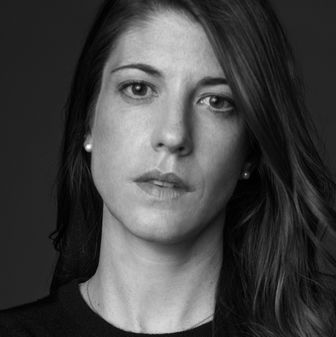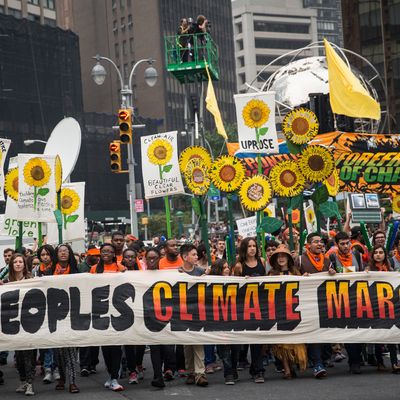
People’s Climate March organizers estimate nearly 400,000 people from across the globe made the 50-block trek from the Museum of Natural History, through Times Square, to the Javits Center yesterday to raise attention around environmental issues on the eve of the U.N. Climate Summit. Marchers banged drums, twirled flags, danced through the streets, sang dirges, and put a new spin on old protest favorites. (One, Two, Three, Four, climate change is class war.)
The concerns — pollution in the Gowanus Canal, uranium in the Black Hills, dying lions — were as diverse as the crowd. Daily Intelligencer caught up with marchers to find out what got them out of bed and into the street on a Sunday morning.
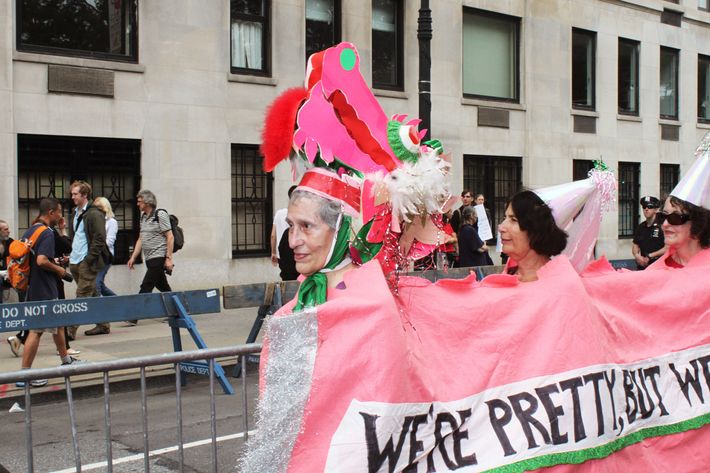
Anne Hanson, 75
Warwick, New York
What are you wearing?
Several years ago we had a pantomime group to protest the war and we made the dragon, and bring it out for special occasions. Since it has the message about carbon pollution, we thought it would be perfect here.
What makes this a special occasion?
The scope, and the presence of the United Nations.
What got you out the door this morning?
Part of it is personal: I want to show up for things I believe in. And I think we have to do everything we can do on a local level to spur the national level to understand this is serious.
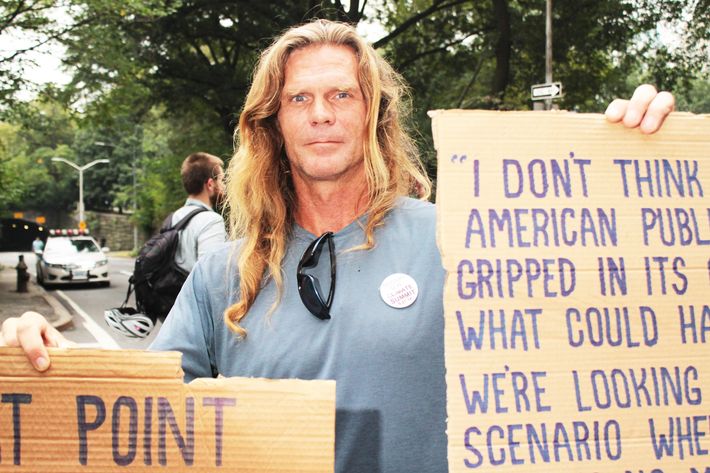
Barry Knight, 46, Economist/Activist
Framingham, Massachusetts
I overheard you say you might be getting arrested tomorrow?
Yeah. I don’t want to go into too many details about that, but we know Flood Wall Street is tomorrow. Petitions and protests are wonderful and they will draw attention to certain issues, but the protests often don’t have any effect and petitions often fall on deaf ears, so if we want to stop global warming we have to be righteous and throw ourselves into the machine and disrupt the machine that is destroying our environment.
As long as our government continues to be owned and operated by the worst polluters in the corporations, little will happen because they dictate our legislature. It’s time for the people to take the power back, and I like the numbers here, but we’ve got to do more than protest and call our politicians. We need to stop this, and that is going to take direct, physical, nonviolent action.
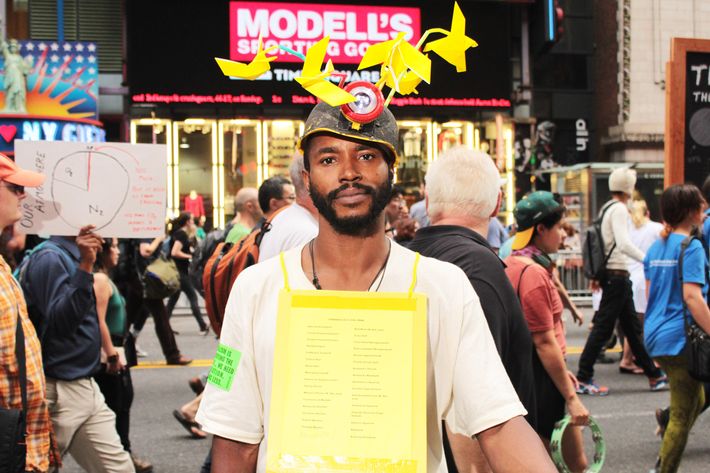
Clarence Brimley Jr., 34
New York, New York
What brings you out today?
Changing the planet to renewable energy. My life, your life, our lives that we lead. Our actions today can change the world tomorrow.
You think so?
I believe we are capable of it. Will we do it? I’m not sure yet. I still have a little doubt, because we have people that like money. It can happen, but we need more of us to come together because their dollars outnumber us right now.
Tell me about what you are wearing.
This is a list of all the birds that were used in coal mining, you know how they brought the canaries down into the coal mine.
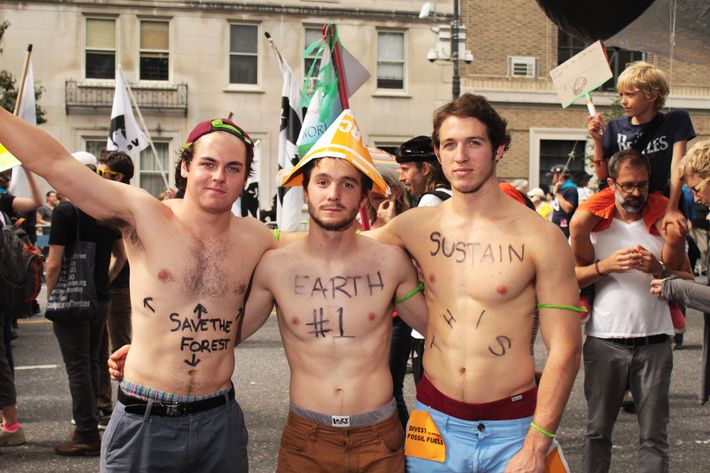
Coremac Curley, 19, Student
Ross Henry, 20, Student
Max Renner, Student
Burlington, Vermont
What got you up this morning?
Ross: We go to school in Vermont, and since Vermont is so radical in its environmental ideas and mindsets, I feel like I need to support it.
Max: I’m personally disgusted with the Kyoto Protocol, where the U.S. didn’t sign it, so that’s what made me come down here. Hopefully I’m another body.
What change would you like to see?
Ross: If you take one of those carbon footprint quizzes of how many Earths does it take to sustain you — we are at like 3.5 or 4.5 Earths, depending on how you live. We need to be closer to 1. Do we really want to look back and say we are the ones that messed this up, that we are the ones who are responsible for messing this up? No one wants to be that person.
Coremac: Living in America, it takes at least four Earths to live here.
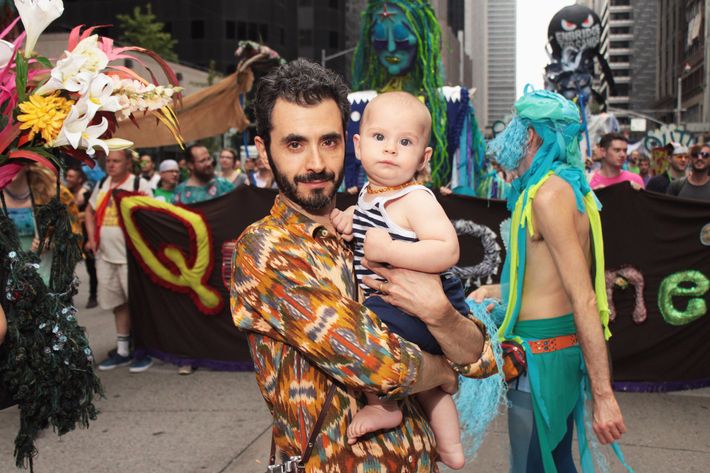
Jamal Panagacos, 42, Rug Salesman and Kai, 7 months
New York, New York
What got you out of the house this morning?
I guess brunch. That was where it started.
Was there any motivating factor for you?
It is just about our lifestyle. We only shop at the farmers’ market for food and we try to buy small companies, and we’re not against importing but we’ll always look for something local. As people do this, they should change their lifestyle to match the march. Not just come out once, but live it. If you live it, this will work. If they march, it is just numbers.
How do you try to live it?
Support people, not big companies. If you buy Budweiser and smoke Marlboro, and then come here and march, it is kind of like confession on Sundays. It has to be a lifestyle. It has to be real, or it is just Facebook and Twitter and Instagram.
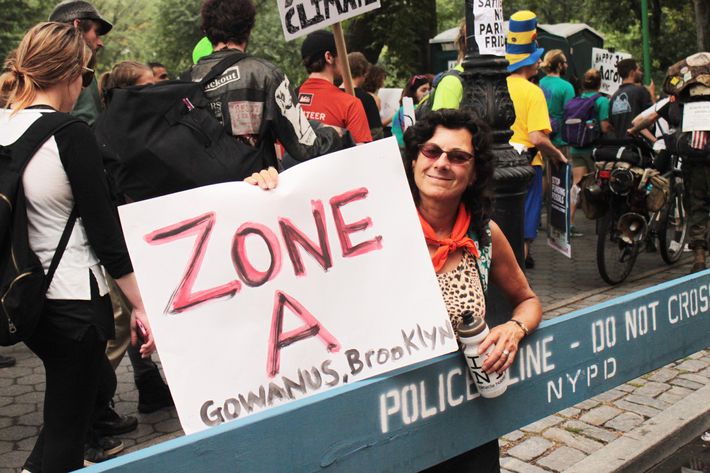
Judy Richardson, 58, Artist/ Teacher
Brooklyn, New York
What brings you out today?
Everything. I try to do everything I can to help this issue of climate change. This issue is in opposition to most business development, but on a local level, at the Gowanus Canal, it is a really huge issue. It is a polluted site, a superfund site, and there is a huge development about 700 apartments going up right next to it; the land hasn’t been remediated. We take our row boat out on the canal; there are at least 30 drain pipes between where we go in and the harbor that are still putting pollution into the canal every day. So it is not just an old issue, it is a current issue.
What makes you believe there is pollution going into the canal?
We can see it. It is gross. It is extremely gross after it rains. National Grid has pipelines there, and there is always a film of gas on the surface. We are on the water in a boat, and we can see it, and smell it.
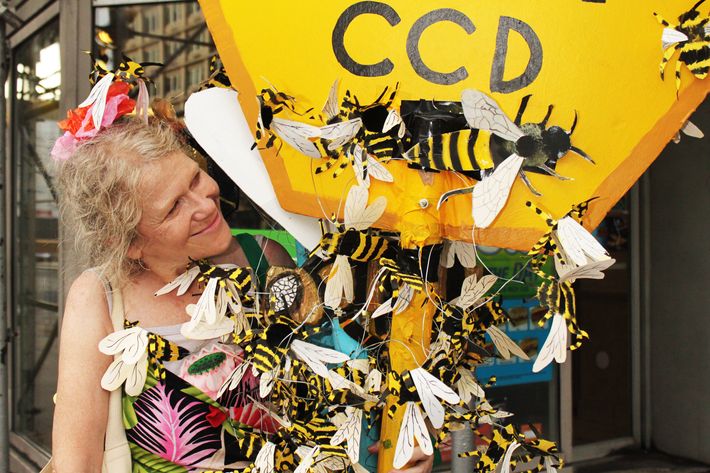
Morgan Jeness, 57, Teacher
New York, New York
I understand you came out with beekeepers?
Yes, we were out with the beekeepers and Reverend Billy. I worked with the People’s Puppets at Occupy Wall Street, so we do a lot of puppets, and banners and images like this for various actions, unions, and things like that. These butterflies are made out of recycled manila file folders.
What were the beekeepers wanting to raise attention about?
The main issue is colonies collapsing because so many of them are used in industrial agriculture and they’ll move the hives from one field to another. Honeybees tend to eat a lot of different pollen, which is what makes them strong. So if they are only feeding young bees one type of pollen, it really weakens the hive and weakens the colony.
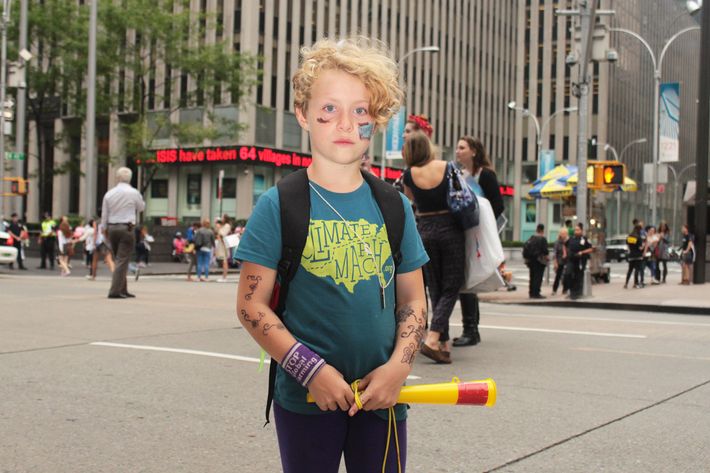
Poppy McGuire, 9
Edina, Missouri
Your dad said you walked 20 miles to get here?
Yeah. It was half on my bike.
What was that like?
It was pretty hard, but I actually really liked it.
Did your parents have to convince you to come out this morning?
I was kind of scared because lately lots of people have been talking about getting arrested, but then I remember last night my bracelet on and it says stop global warming, and I was like, Oh, I’m going to do this. I’m a child, why am I worrying about this thing? I should just do it. And so I came out here and did it.
You were nervous because there were so many people?
Yeah, so many people. This morning I kind of regretted coming because I asked somebody to hold my sign for a second and then they walked away, so I spent like an hour looking for my sign. It said, “Rest in Peace lions” because all the lions are dying with all the droughts. All the other animals are dying, like the giraffes, so they don’t have anything to eat.
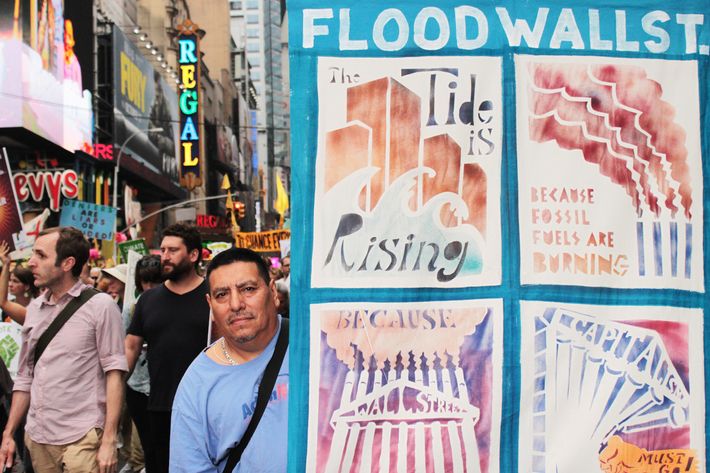
Rogelio Reyes
Charlotte, North Carolina
Are you going to Flood Wall Street tomorrow?
I don’t know, because I have to talk to my boss. I might have to go back to Charlotte tonight.
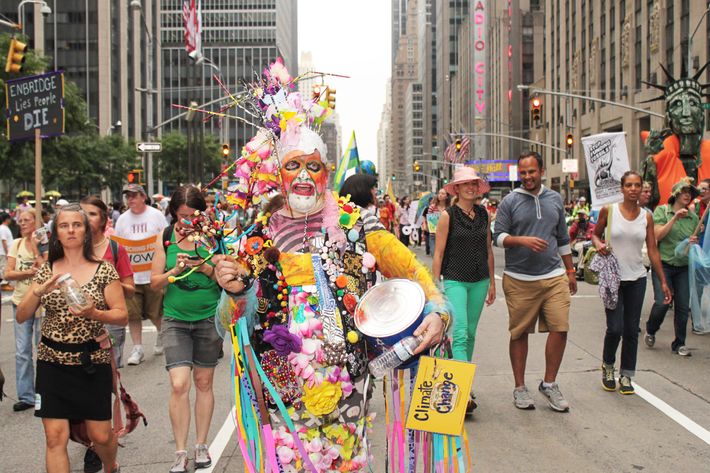
Rolando Vega, 61, Artist
New York, New York
How did you put together your outfit today?
I dress up a lot; I’ve been dressing up for 40 years. I’m well respected, so it is good to come out and show off and keep people’s minds on the right things.
As a parade expert, what do you think of this turnout?
It feels good, but I hope people didn’t travel much to get here because burning fuel is not the way to do it. I wasn’t thinking about it too much until I went to Burning Man last year _ that was horrifying. It’s a fuel-burning festival. The least amount of time it takes to get there is 12 fucking hours. To get there! So imagine 68,000 people. Then it is a 24-7 festival. Use the dark. Learn this shit, it ain’t all a fucking light show. Rock and roll is over.
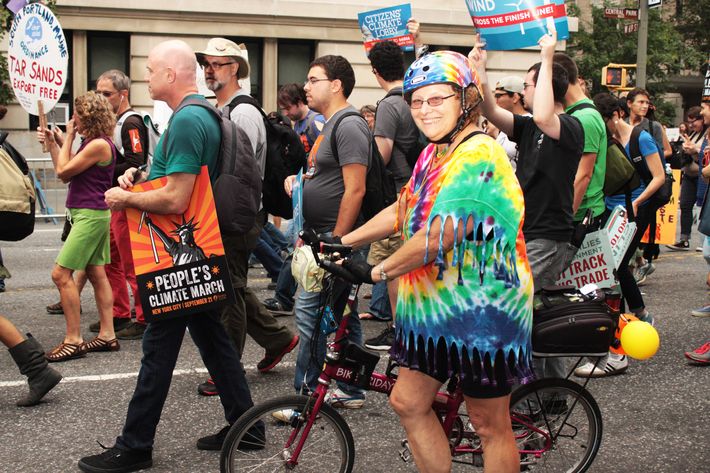
Sharon Behnke, 67, Semi-retired
Bronx, New York
What got you out of the house this morning?
Really just a chance to bike, I’m not into activism so much, but I do believe in cycling. I believe in bicycles are good for the environment, and they are good for your body. It’s the best way to get around in the city.
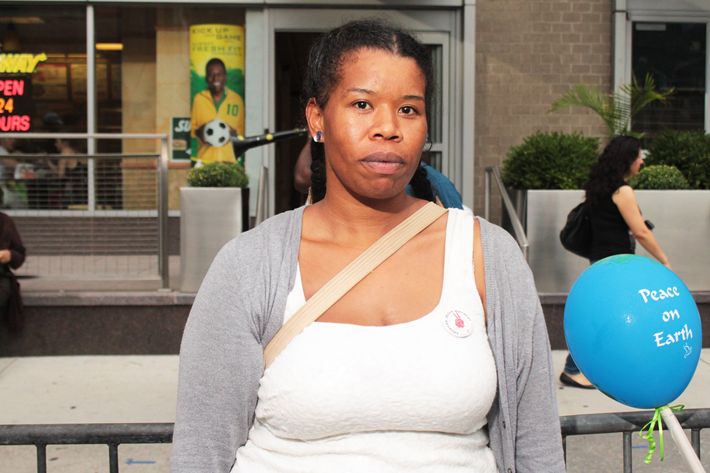
Sonia Little, 30, Nursing Student
Mashpee, Massachusetts
What brings you out today?
I’m Mashpee-Wampanoag, from the Wampanoag people. I hopped a rideshare with a Quaker from Vermont to be a part of everybody out here. Me and one other monk walked two weeks before Occupy Wall Street from Queens to Wall Street chanting. It was just the two of us and there were so many people looking at us.
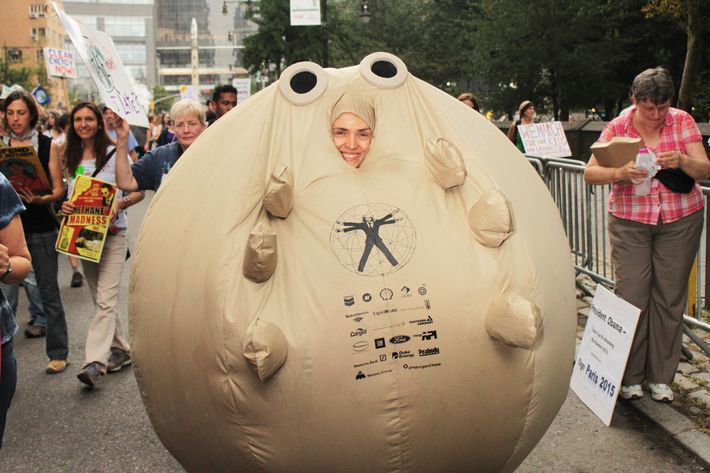
Xenia, 33, Filmmaker
New York, New York
This is a survival ball?
Yes, this is a survival ball. It has all you need to survive. You can float in it, you can fly in it, you can sleep in it, you can hibernate — you are all set. They are really expensive, but if things go the way they are right now, we won’t be able to survive with out this. I’m just prepping myself in advance for when it hits.
Do you wear clothes underneath the survival ball?
Yeah, I wear my regular clothes.
What got you to the Upper West Side on a Sunday morning?
It is a strange question because my question would rather be, What made people who are not here stay home?


